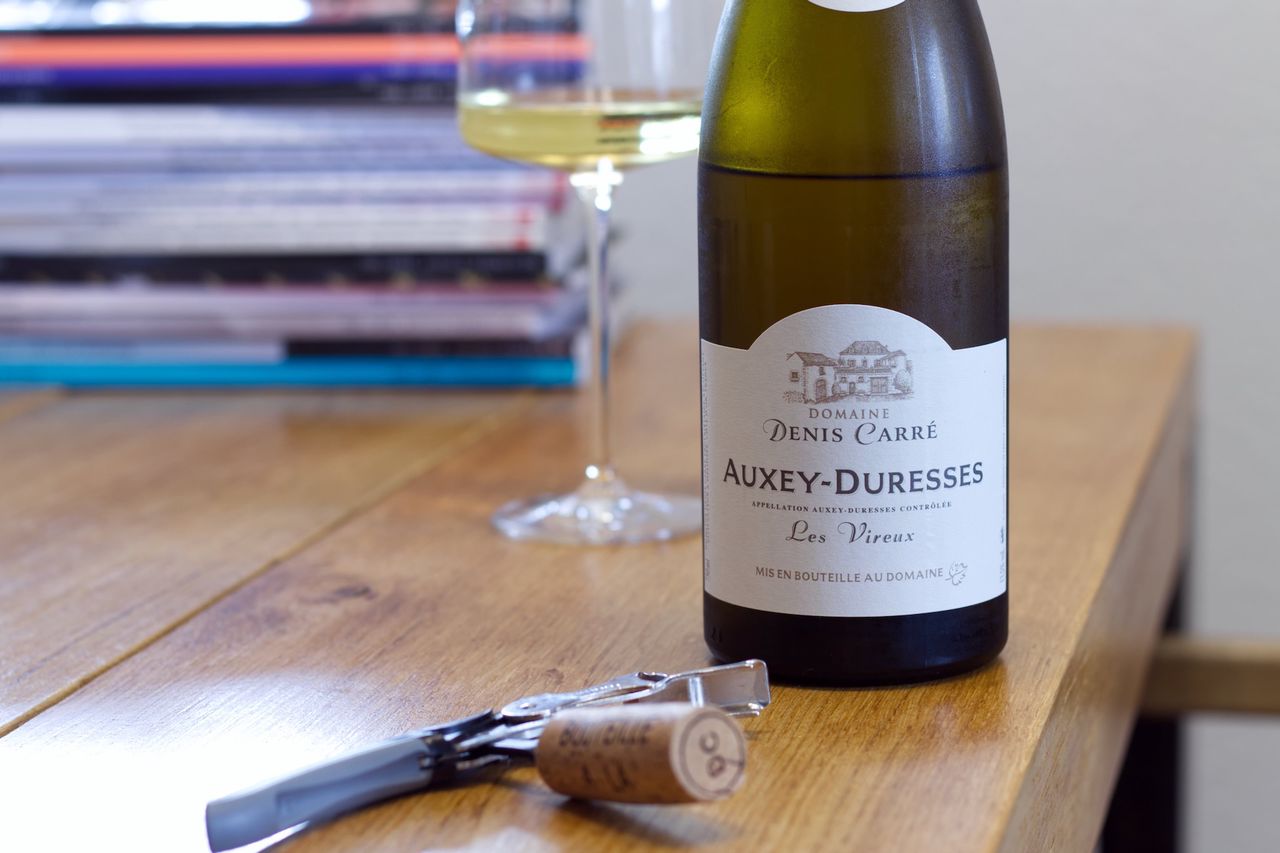Domaine Denis Carré - Auxey-Duresses Les Vireux 2021
We are drinking a bottle of 2021 Chardonnay Auxey-Duresses Les Vireux from Domaine Denis Carré in Burgundy.

The last four bottles of Burgundy in the glass have been a bit too enjoyable for me to want to stop now. However, there will be some variety. For one, the next bottles of Burgundy will actually come from Burgundy itself, and for another, they won’t be exclusively red. That means Chardonnay this time—at least for now. Aligoté will surely find its way back into the glass at some point as well. I often feel like Burgundy labels give me a sense of déjà vu. You’ve seen, heard, or read them before, but you can’t quite grasp them, and it feels like the harder you think, the bigger the mental gap becomes. Burgundy is filled with so many place names and vineyard sites, it’s overwhelming. At least, unlike here, they often sound somewhat refined. Maybe that’s because my French isn’t strong enough to recognize the Burgundy equivalent of something like Kreuznacher Krötenpfuhl (Toad Pond of Kreuznach). It could also be that the truly big names cast a shadow over the smaller sites. Still, I’d like a clearer picture in my head when I come across such labels. Time to learn something new.
Auxey-Duresses is a small village that borders Meursault to the northwest, with just over 130 hectares in the appellation of the same name. About two-thirds of the area is planted with Pinot Noir, the rest with Chardonnay. To the south of the village is the vineyard Les Vireux, situated on a slope directly beneath a small forest, with an eastern view. Not too long ago, this might have been considered a less desirable orientation due to reduced sunlight. But now, with climate change, it’s considered more of a cool climate site. If you’re not careful and take a few steps too far, you’ll find yourself in Meursault. The vineyard plots are small, and the boundaries are what they are, sometimes just a couple of rows of vines can mean the difference of a few hundred or thousand euros per bottle. It’s crazy. Denis Carré founded his winery in 1975 with his wife in the even smaller village of Meloisey, further north, without owning any vineyards. Today, their two children, Gaëtane and Martial, manage the 12 hectares they’ve gradually acquired, and the estate has been certified organic for a few years.
The wine has a bit of oak and a fine, creamy texture on the nose, along with a slight reduction, which gives you the feeling that it can be swept aside like a curtain when you swirl the glass, only to reappear after a few minutes of stillness. That’s pretty cool. The wine has great tension on the palate, with the fruit starting off subtle, mostly orchard fruits, before intensifying into pear, then settling comfortably with a slight astringency on the tongue. After swallowing, there’s a lingering salty, mineral finish. It’s dense yet incredibly fine, fresh, and with each sip, it becomes crisper. Recently, especially at the Maxime Open, we’ve had quite a few German Chardonnays in the glass. While many of them were good, this effortless depth, elegance with just the right amount of reduction, and that cool tension, it’s rare to find that.
Not much changes overnight. The wine remains precise, crisp, and crystal clear. Rather than opening up, it becomes more restrained, a bit more reserved. The effect of swirling to create a window into the wine doesn’t work as well once it’s straight out of the fridge. Here we go again with the feeling of backward development over time that we encountered with the Pinot Noirs as well. The wine becomes leaner, the structure and mouthfeel take over from the fruit. The oak and that touch of reduction now dominate, while the fruit only flashes here and there, showing hints of pear or citrus. Temperature plays a big role too. On a warm evening like the one we have this, I prefer to pour it a few degrees too cold, knowing it will warm up on its own. This makes the fruit more yellow, the wine a bit more open, but also somehow stronger in its tannic structure. I refrained from stirring with a meat thermometer in the glass, so I don’t really know how warm the wine was. My favorite sip, though, came after half an hour on the living room table, when it still felt slightly cool but no longer cold. Whatever that means in numbers in the attic. That’s when the wine was at its most open and charming, without losing even a hint of precision. It’s really good and the perfect continuation of the last few weeks.
Related Posts
- La Soufrandière - Au Vignerais Zen 2020
- Vin Noé - Pattaya 2022
- Domaine Rougeot - Saint-Romain La Combe Bazin 2021